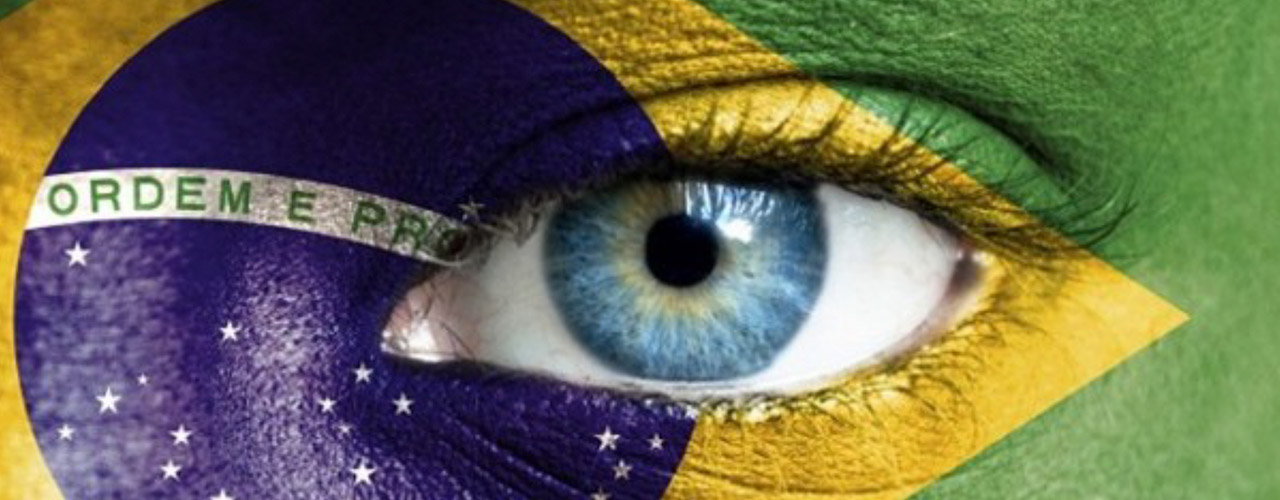
The Beauty Market in Brazil

KEY POINTS
- Brazil is the fourth-largest beauty market in the world, after the US, Japan and China. The country accounts for 9.4% of the global market, according to Associação Brasileira da Indústria de Higiene Pessoal, Perfumaria e Cosméticos (Brazilian Association for the Personal Hygiene, Perfume, and Cosmetics Industry – ABIHPEC), and the beauty market accounts for 1.8% of Brazil’s GDP. In 2015, category sales in the country totaled more than US$31 billion, according to Euromonitor International.
- Culturally, beauty and personal care are very important in Brazil. Brazilians take, on average, 12 showers a week according to The Atlantic, leading to high consumption of hygiene-related products and fragrances.
- In Brazil, the most common way to purchase makeup is through direct-selling retailers.
- According to ABIHPEC, in 2015, the Brazilian beauty industry exported US$98 million worth of products to 134 countries; imports amounted to US$1.71 billion. Argentina is Brazil’s biggest trading partner, followed by the US and France.
OVERVIEW
Brazil is the fourth-largest beauty market in the world, after the US, Japan and China. The country accounts for 9.4% of the global market, according to ABIHPEC, and the beauty industry accounts for 1.8% of Brazil’s GDP. According to Euromonitor International, the Brazilian beauty and personal care industry grew at a 9.5% CAGR between 2010 and 2015, and was worth more than US$31 billion last year.
Brazil is the number one consumer of deodorant, fragrances and sun protection in the world. It ranks second in consumption of baby care, men’s hygiene, hair, bath and depilatory products, and third for oral hygiene and makeup products according to ABIHPEC. According to Stylist magazine, Brazilian women spend 11 times more of their annual income as a percentage of their total income on beauty products than women in the UK.
The health and beauty market has maintained strong growth despite the economic downturn in Brazil. Known as the “lipstick effect,” many women in the country have cut back on self-indulgent purchases, such as expensive high heels, during the recession, but have continued to sporadically buy cheaper lipsticks as small but rewarding purchases, keeping the beauty market afloat. According to market research firm Mintel, 24% of Brazilian women say buying new things makes them happy, while 81% of Brazilian women find getting a bargain thrilling.
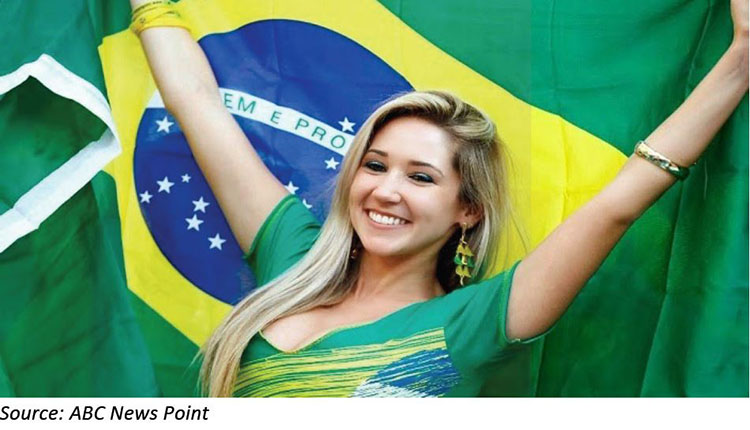
Brazil has also recently adopted the health and wellness trend, as much of the population has emerged into the middle class after years of economic growth. Along with Brazilians’ strong penchant for personal grooming, the health and wellness trend has driven market growth. Despite the economic slowdown, Brazil’s beauty and personal care market grew by 57.6% between 2010 and 2015 according to Euromonitor. Euromonitor forecasts that it will grow by 14.3% between 2015 and 2020, at a CAGR of 2.7%, although the firm expects the premium beauty and personal care market to grow even faster, by 29.1% over the same period, at a CAGR of 5.2%.
According to Euromonitor, Brazilian health and beauty specialist retailers saw a 9% increase in current value growth in 2015 compared to 2014, partly due to an increase in taxes on beauty products and the devaluation of the real. The sector is expected to see the strongest growth within non-grocery retailers, with a 2% value CAGR between 2015 and 2016 at constant 2015 prices, according to Euromonitor. Drugstores and pharmacies are expected to continue to benefit from the health and wellness trend in Brazil, growing at an estimated 3% value CAGR in 2016.
Culturally, beauty and personal care are very important in Brazil. According to The Atlantic, Brazilians take, on average, 12 showers a week, leading to high consumption of hygiene-related products and fragrances.

BEAUTY AND PERSONAL CARE
Premium beauty and personal care product sales in Brazil have grown almost twice as fast as sales of mass-market products, as seen in the table below. Euromonitor data suggest that the premium category grew by 23% year over year in 2015 despite the unfavorable macroeconomic conditions, reflecting consumers’ preference for products with higher-quality ingredients and recognized brand names.
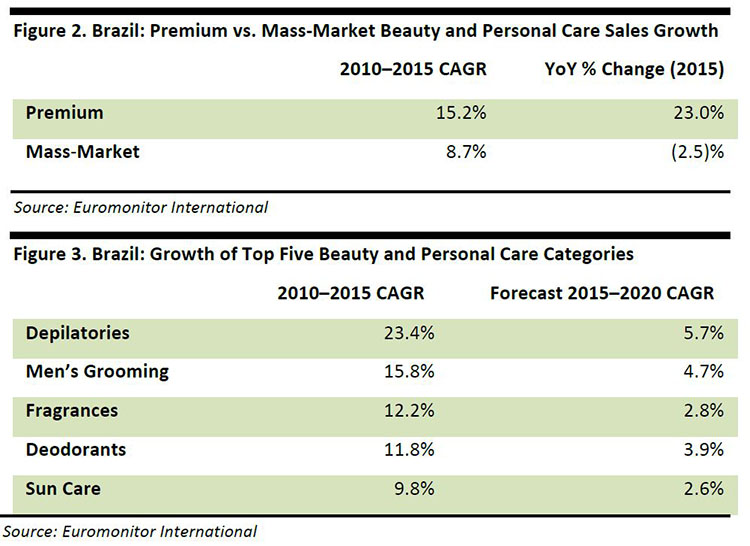
KEY PLAYERS
The key players in Brazil’s beauty market include both domestic and international brands, some of which we profile below. Other relevant brands include Unilever, L’Oréal and Mary Kay.
Natura Cosméticos
Natura Cosméticos is a Brazil-based manufacturer and direct seller of beauty and personal care products. According to Euromonitor, in 2015, it ranked 16th in the world in terms of beauty and personal care value share, and first in Brazil. The company is particularly concerned with its social message, maintaining an environmentally friendly stance with each of its products.
In 2015, Natura reported sales of US$2.4 billion; 98% of the company’s sales were generated in Latin America, and 76% in Brazil alone. The company reported 8.6% growth globally in 2015, though revenue in Brazil fell by 3.6%. Natura’s share of the Brazilian market slipped from 15% to 11% between 2010 and 2015. The company opened its first brick-and-mortar location in 2016, in São Paulo, and announced plans to open more stores in the coming years.
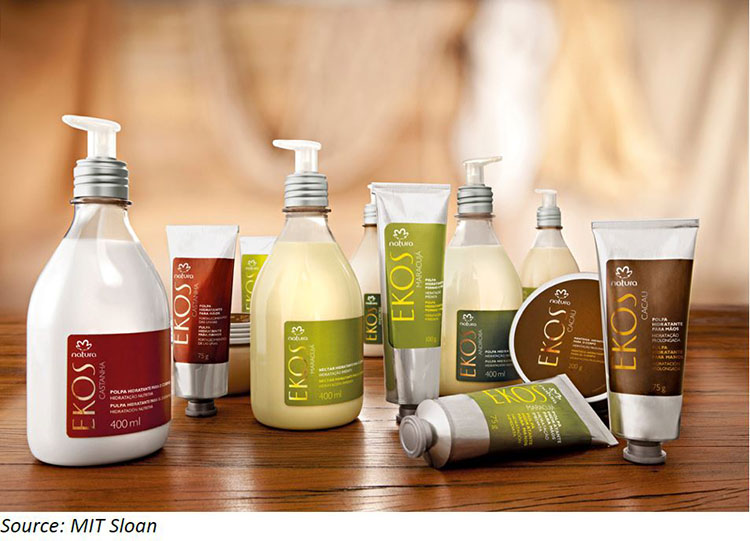
Grupo Boticário
Grupo Boticário is the owner of the O Boticário beauty specialist retailer, founded in 1977. The company is 100% privately owned and the second-largest beauty specialist within the Brazilian market, generating 99% of its sales domestically. O Boticário is the market leader for fragrances in Brazil. In 2012, the company founded a series of stores called Quem Disse, Berenice? (“Who Said, Berenice?”) that are dedicated to makeup and fragrances. The chain is very popular in Brazil due to its powerful ad campaign that includes women of all ages, colors and sizes. At the same time, the company launched The Beauty Box, which is a smaller-format, boutique-style store that sells multiple brands and has a strong e-commerce presence.
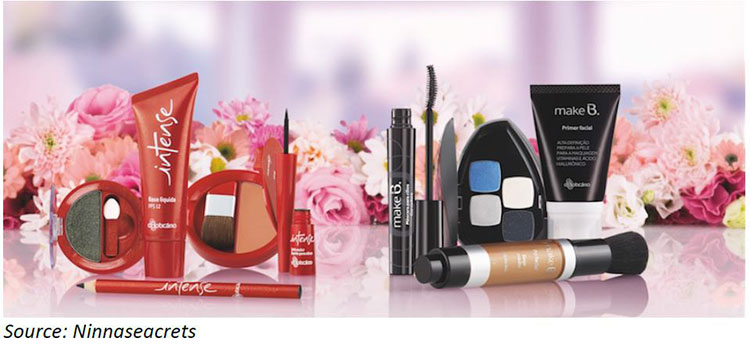
Avon Products
Avon Products has been operating in Brazil since 1958. In 2015, Avon represented approximately 8% of the global direct-selling sales force, with 8 million representatives, 1.5 million of which are in Brazil. Brazil accounts for 17% of Avon’s global market; one in every two lipsticks sold in Brazil is Avon brand, and an Avon mascara is sold every 1.5 seconds in the country.
Avon is currently implementing aggressive improvements in its e-commerce platform. In Brazil, Avon offers free shipping on orders over R$99 (US$30). On orders over R$60 (US$20), the company allows customers to pay in up to six monthly installments, interest-free, which is customary in Brazil.
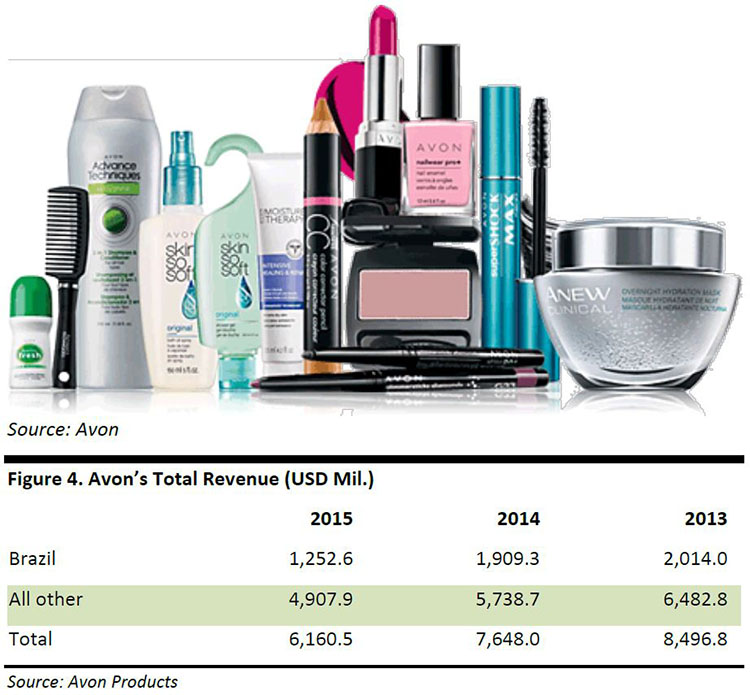
DISTRIBUTION CHANNELS
In Brazil, the most common way to purchase makeup is through direct-selling retailers. Natura sells its products through its 1.4 million Natura Consultants in Brazil, and the company has an additional half million consultants throughout Latin America and France. Brazil serves as Avon’s largest market, contributing more than 10% of the company’s consolidated revenues, although the company has noted that declining revenues have been affected by the Brazilian market and increased competition from Internet retailing and diversified distribution channels.
Currently, no considerable Internet sales are generated for depilatories, oral care and products packaged as sets/kits in Brazil, while fragrances have the strongest online presence among all categories, generating 7.9% of the beauty category’s retail value.
Hair care and oral care products are mostly sold in stores, which account for 93% and 99.8% of their respective retail values. Direct selling accounts for the lowest share of sales in both categories: only 6.2% of hair care sales and 0.2% of oral care sales are made through direct sales in Brazil.

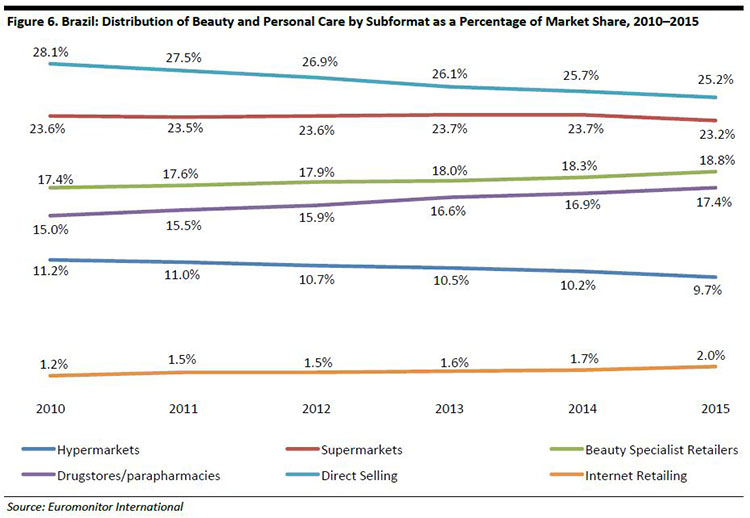
IMPORTS AND EXPORTS
In 2015, the Brazilian beauty industry exported products to 134 countries. Argentina is Brazil’s main trading partner, followed by the US and France.
 The economic environment in Brazil in recent years has caused a deficit in the balance of trade due to the devaluation of the real, resulting in a 7.0% decrease in exports and a 4.6% decrease in imports in 2014 across all markets. In the last decade, the Brazilian beauty industry’s exports grew at an average CAGR of 7.5% per year and its imports at an average CAGR of 19.5% per year. The trade deficit decreased between 2013 and 2014 due to the devaluation of the real. In 2014, exports increased by 1.9% year over year, while imports decreased by 10.4%.
The economic environment in Brazil in recent years has caused a deficit in the balance of trade due to the devaluation of the real, resulting in a 7.0% decrease in exports and a 4.6% decrease in imports in 2014 across all markets. In the last decade, the Brazilian beauty industry’s exports grew at an average CAGR of 7.5% per year and its imports at an average CAGR of 19.5% per year. The trade deficit decreased between 2013 and 2014 due to the devaluation of the real. In 2014, exports increased by 1.9% year over year, while imports decreased by 10.4%.
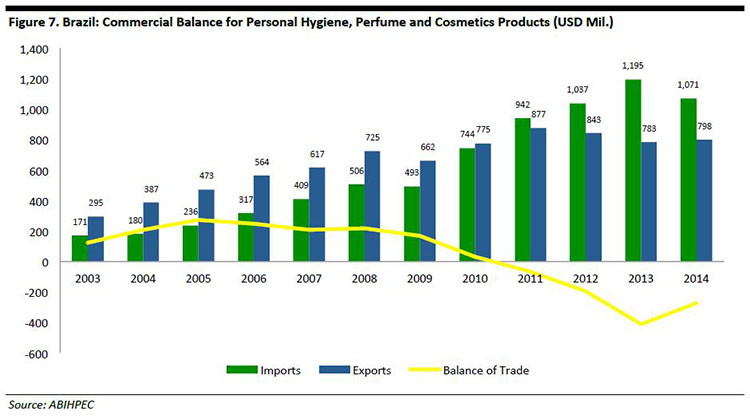

TAX STRUCTURE
In 2015, the Brazilian government implemented a tax on industrialized products, which affected cosmetics distributors. ABIHPEC estimates that the new tax cost beauty industry businesses approximately R$900 million (US$277 million) last year. The tax particularly affected products that are taxed at a rate above 15%; these include fragrances, makeup, shaving cream, nail polish, hair products (excluding shampoo and conditioner), lotions and skin creams. The tax will have an average impact of 12% on prices according to ABIHPEC.
BEAUTY TRENDS
Cosmetics consumption in Brazil is driven by new beauty trends, particularly those related to social media, and YouTube tutorials and Instagram stars have boosted beauty sales in recent years. According to ABIHPEC, 22% of women in Brazil have used social media tutorials as a way to learn about new makeup.
In 2015, online media company Signature9 ranked the 99 most influential fashion and beauty blogs, and deemed Brazil home to the largest number of such blogs worldwide. Beauty bloggers including Julia Petit, Camila Coutinho and Victoria Ceridono have a huge global following. Petit started by doing hair and makeup tutorials on YouTube, but now garners nearly 9 million monthly visits to her website, which is one of the most popular in Brazil.
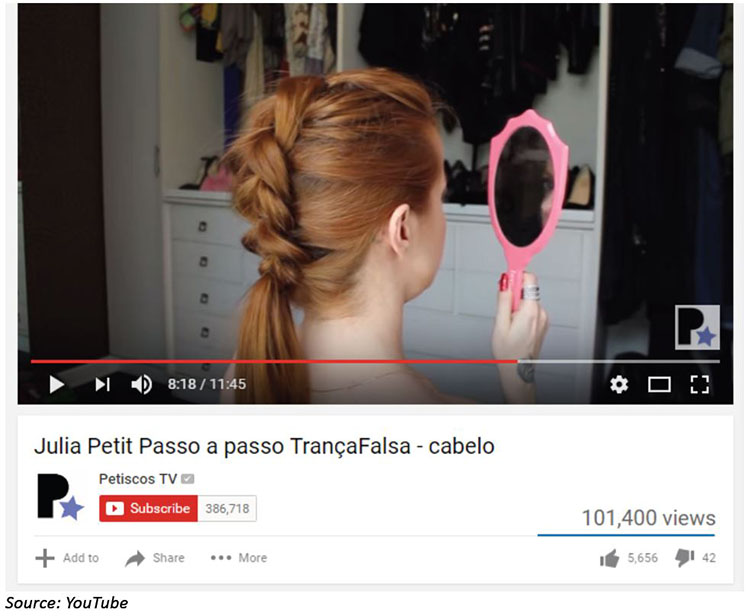
In Brazil, women are becoming increasingly aware about ingredients in makeup, and 82% of women say they prefer products containing natural ingredients according to ABIHPEC.
Additionally, 74% of Brazilian women prefer to try makeup before they buy it, which is why the direct-selling channel is so popular in the country. New players in other channels are popping up to cater to this preference. In January 2015, a startup called Veggie Box came onto the scene. Veggie Box sends organic, vegan and cruelty-free cosmetics to its subscribers for R$79.90 (US$25) per month. The company has increased its client base at a rate of 30% per month and is currently expanding into men’s products, including shave balms, shaving creams and after-shaves, razors, shampoo and conditioners, lotions, oral hygiene, and aromatherapy.
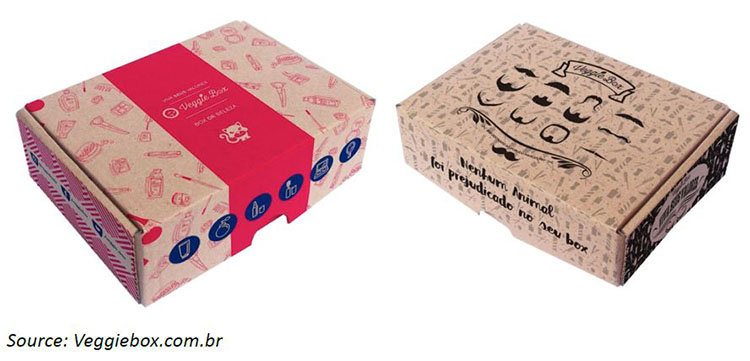 Some Brazilian trends have made their way into international markets. Particularly influential has been the Brazilian blowout, a keratin hair treatment that helps manage frizz and texture, making hair smoother and easier to style. Keratin treatments have become available in salons across the world, and beauty brands such as Suave and John Frieda have released product lines capitalizing on the Brazilian trend.
Some Brazilian trends have made their way into international markets. Particularly influential has been the Brazilian blowout, a keratin hair treatment that helps manage frizz and texture, making hair smoother and easier to style. Keratin treatments have become available in salons across the world, and beauty brands such as Suave and John Frieda have released product lines capitalizing on the Brazilian trend.
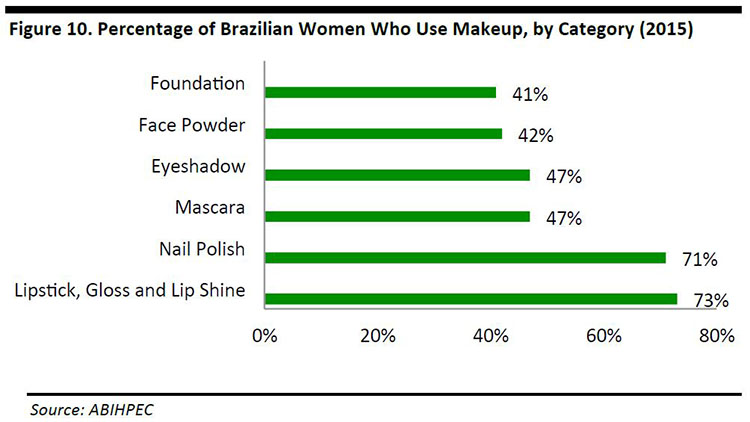 Younger consumers, particularly Gen Zers, have become more important in the Brazilian beauty market, and many large companies have created makeup lines that are targeted toward this younger demographic.
Younger consumers, particularly Gen Zers, have become more important in the Brazilian beauty market, and many large companies have created makeup lines that are targeted toward this younger demographic.
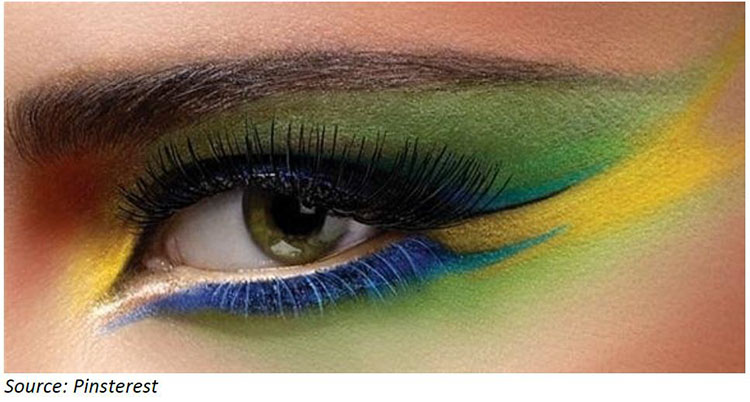
FORECASTS
While growth of the Brazilian beauty market slowed in 2015, Euromonitor expects it to pick back up as beauty and personal brands adapt to the changing retail climate and adopt multi-channel strategies. In the coming years, we will likely see direct-selling beauty and personal care retailers in Brazil strengthen their brick-and-mortar presence, and see franchises expand into direct selling.
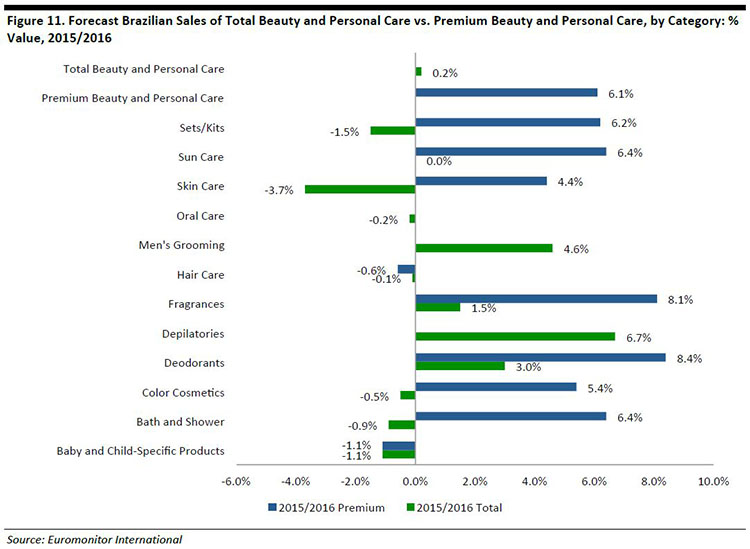
Euromonitor forecasts that the Brazilian premium beauty and personal care market will grow by 6.1% in 2016, while mass-market product sales will decline by 0.2%.The total beauty and personal care market in Brazil is expected to increase by 0.2%.
